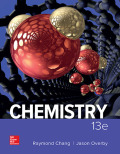
Chemistry
13th Edition
ISBN: 9781260162370
Author: Chang
Publisher: MCG
expand_more
expand_more
format_list_bulleted
Question
Chapter 25, Problem 25.6QP
Interpretation Introduction
Interpretation:
The colligative properties that are suitable for determining the molar mass of a
Concept Introduction:
Colligative properties are properties of the solutions that depend upon the concentration of solute particles in the solution. They are lowering of vapor pressure, elevation of boiling point, depression in freezing point and osmotic pressure.
Expert Solution & Answer
Want to see the full answer?
Check out a sample textbook solution
Students have asked these similar questions
None
A complete tensile test was performed on a magnesium
specimen of 12 mm diameter and 30 mm length, until breaking.
The specimen is assumed to maintain a constant volume.
Calculate the approximate value of the actual stress at breaking.
TABLE. The tensile force F and the length of the specimen are
represented for each L until breaking.
F/N
L/mm
0
30,0000
30,0296
5000
10000 30,0592
15000 30,0888
20000
30,15
25000 30,51
26500
30,90
27000
31,50
26500
32,10
25000 32,79
None
Chapter 25 Solutions
Chemistry
Ch. 25 - Prob. 25.1QPCh. 25 - Prob. 25.2QPCh. 25 - Prob. 25.3QPCh. 25 - Prob. 25.4QPCh. 25 - Prob. 25.5QPCh. 25 - Prob. 25.6QPCh. 25 - Prob. 25.7QPCh. 25 - Prob. 25.8QPCh. 25 - Prob. 25.9QPCh. 25 - Prob. 25.10QP
Ch. 25 - Prob. 25.11QPCh. 25 - Prob. 25.12QPCh. 25 - Prob. 25.13QPCh. 25 - Prob. 25.14QPCh. 25 - Prob. 25.15QPCh. 25 - Prob. 25.16QPCh. 25 - Prob. 25.17QPCh. 25 - Prob. 25.18QPCh. 25 - Prob. 25.19QPCh. 25 - Prob. 25.20QPCh. 25 - Prob. 25.21QPCh. 25 - Prob. 25.22QPCh. 25 - Prob. 25.23QPCh. 25 - Prob. 25.24QPCh. 25 - Prob. 25.25QPCh. 25 - Prob. 25.26QPCh. 25 - Discuss the importance of hydrogen bonding in...Ch. 25 - Proteins vary widely in structure, whereas nucleic...Ch. 25 - Prob. 25.29QPCh. 25 - Prob. 25.30QPCh. 25 - Prob. 25.31QPCh. 25 - Prob. 25.32QPCh. 25 - Prob. 25.33QPCh. 25 - Prob. 25.34QPCh. 25 - Prob. 25.35QPCh. 25 - Chemical analysis shows that hemoglobin contains...Ch. 25 - Prob. 25.37QPCh. 25 - What kind of intermolecular forces are responsible...Ch. 25 - Draw structures of the nucleotides containing the...Ch. 25 - Prob. 25.40QPCh. 25 - Prob. 25.41QPCh. 25 - Prob. 25.42QPCh. 25 - Prob. 25.43QPCh. 25 - Prob. 25.44QPCh. 25 - When deoxyhemoglobin crystals are exposed to...Ch. 25 - Prob. 25.46QPCh. 25 - Prob. 25.47QPCh. 25 - Prob. 25.48QPCh. 25 - Prob. 25.49QPCh. 25 - Prob. 25.50QPCh. 25 - Prob. 25.51QPCh. 25 - Assume the energy of hydrogen bonds per base pair...Ch. 25 - Prob. 25.53QP
Knowledge Booster
Similar questions
- Differentiate between plastic deformation, elastic deformation, viscoelastic deformation and viscoplastic deformation.arrow_forward1.57 Draw all reasonable resonance structures for the following cation. Then draw the resonance hybrid.arrow_forwardFor the two questions below, draw the mechanism and form the major product.arrow_forward
- Indicate similarities and differences between natural, exchanged and pillared clays.arrow_forwardShow work. don't give Ai generated solutionarrow_forwardIn intercalation compounds, their sheets can be neutral or have a negative or positive charge, depending on the nature of the incorporated species and its structure. Is this statement correct?arrow_forward
- This thermodynamic cycle describes the formation of an ionic compound MX2 from a metal element M and nonmetal element X in their standard states. What is the lattice enthalpy of MX2 ? What is the enthalpy formation of MX2 ? Suppose both the heat of sublimation of M and the ionization enthalpy of M were smaller. Would MX2 be more stable? Or less? or impossible to tell without more information?arrow_forward7. Draw the mechanism to describe the following transformation: Note: This is a base catalyzed reaction. So, the last steps must make [OH]- OH [OH]¯ OH Heat Oarrow_forwardShow work with explanation...don't give Ai generated solutionarrow_forward
arrow_back_ios
SEE MORE QUESTIONS
arrow_forward_ios
Recommended textbooks for you
- Chemistry: Matter and ChangeChemistryISBN:9780078746376Author:Dinah Zike, Laurel Dingrando, Nicholas Hainen, Cheryl WistromPublisher:Glencoe/McGraw-Hill School Pub Co
 World of Chemistry, 3rd editionChemistryISBN:9781133109655Author:Steven S. Zumdahl, Susan L. Zumdahl, Donald J. DeCostePublisher:Brooks / Cole / Cengage Learning
World of Chemistry, 3rd editionChemistryISBN:9781133109655Author:Steven S. Zumdahl, Susan L. Zumdahl, Donald J. DeCostePublisher:Brooks / Cole / Cengage Learning Chemistry for Today: General, Organic, and Bioche...ChemistryISBN:9781305960060Author:Spencer L. Seager, Michael R. Slabaugh, Maren S. HansenPublisher:Cengage Learning
Chemistry for Today: General, Organic, and Bioche...ChemistryISBN:9781305960060Author:Spencer L. Seager, Michael R. Slabaugh, Maren S. HansenPublisher:Cengage Learning  Chemistry: The Molecular ScienceChemistryISBN:9781285199047Author:John W. Moore, Conrad L. StanitskiPublisher:Cengage Learning
Chemistry: The Molecular ScienceChemistryISBN:9781285199047Author:John W. Moore, Conrad L. StanitskiPublisher:Cengage Learning Chemistry & Chemical ReactivityChemistryISBN:9781337399074Author:John C. Kotz, Paul M. Treichel, John Townsend, David TreichelPublisher:Cengage Learning
Chemistry & Chemical ReactivityChemistryISBN:9781337399074Author:John C. Kotz, Paul M. Treichel, John Townsend, David TreichelPublisher:Cengage Learning Chemistry & Chemical ReactivityChemistryISBN:9781133949640Author:John C. Kotz, Paul M. Treichel, John Townsend, David TreichelPublisher:Cengage Learning
Chemistry & Chemical ReactivityChemistryISBN:9781133949640Author:John C. Kotz, Paul M. Treichel, John Townsend, David TreichelPublisher:Cengage Learning

Chemistry: Matter and Change
Chemistry
ISBN:9780078746376
Author:Dinah Zike, Laurel Dingrando, Nicholas Hainen, Cheryl Wistrom
Publisher:Glencoe/McGraw-Hill School Pub Co

World of Chemistry, 3rd edition
Chemistry
ISBN:9781133109655
Author:Steven S. Zumdahl, Susan L. Zumdahl, Donald J. DeCoste
Publisher:Brooks / Cole / Cengage Learning

Chemistry for Today: General, Organic, and Bioche...
Chemistry
ISBN:9781305960060
Author:Spencer L. Seager, Michael R. Slabaugh, Maren S. Hansen
Publisher:Cengage Learning

Chemistry: The Molecular Science
Chemistry
ISBN:9781285199047
Author:John W. Moore, Conrad L. Stanitski
Publisher:Cengage Learning

Chemistry & Chemical Reactivity
Chemistry
ISBN:9781337399074
Author:John C. Kotz, Paul M. Treichel, John Townsend, David Treichel
Publisher:Cengage Learning

Chemistry & Chemical Reactivity
Chemistry
ISBN:9781133949640
Author:John C. Kotz, Paul M. Treichel, John Townsend, David Treichel
Publisher:Cengage Learning